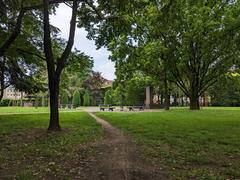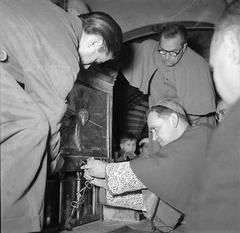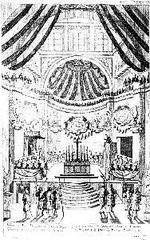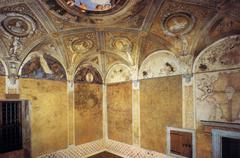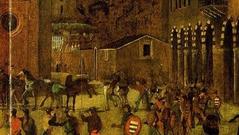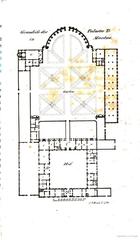Palazzo D’Arco: Visiting Hours, Tickets, and Mantua Historical Sites Guide
Date: 04/07/2025
Introduction
Nestled in the heart of Mantua, Palazzo D’Arco is a beautifully preserved noble residence that offers an immersive journey into Lombardy’s aristocratic past. Evolving from its medieval origins through Renaissance splendor and Neoclassical transformation, the palace today serves as a museum renowned for its outstanding art collections, frescoes, period furnishings, natural history artifacts, and serene gardens. This comprehensive guide details Palazzo D’Arco’s history, significance, visiting hours, ticket information, accessibility, and practical tips for enjoying this and other Mantua historical sites (Wikipedia; finestresullarte.info; museodarcomantova.it).
Historical Overview
Medieval Origins and Early Ownership
The site of Palazzo D’Arco can be traced back to at least the 12th century, possibly housing a royal palace indicative of Mantua’s historic prominence (Wikipedia). The Chieppio family acquired and expanded the property in 1625, and by 1652, it included 63 rooms, reflecting the family’s wealth. The Chieppio lineage ended in 1740, passing the property to Teresa Chieppio and subsequently to the D’Arco family through marriage (it.wikipedia).
The D’Arco Family and Neoclassical Transformation
Giovanni Battista Gherardo d’Arco, a scholar and prominent local figure, commissioned architect Antonio Colonna in 1783 to redesign the palace in the Neoclassical style. The new façade and main structure, completed between 1782 and 1792, harmoniously blended Renaissance and Neoclassical elements. The façade displays the D’Arco and Chieppio coats of arms, as well as the Habsburg eagle, symbolizing the palace’s aristocratic and political connections (it.wikipedia; parcodelmincio.it).
Expansion and 19th-Century Developments
In 1872, the estate expanded with the acquisition of the adjacent Dalla Valle palace. The interiors were enriched with period furnishings, ceramics, silverware, and a substantial library, all reflecting the D’Arco family’s refined tastes. The garden, reminiscent of Bertone Park, and a significant natural history collection assembled by Count Luigi D’Arco, further enhanced the property (parcodelmincio.it).
Twentieth Century: War, Restoration, and Public Legacy
Despite suffering damage during World War II, the palace’s core structure and collections survived. Marchioness Giovanna dei conti d’Arco Chieppio Ardizzoni ensured the palace’s preservation for the public by establishing the Fondazione d’Arco in her will. Upon her death in 1973, the palace became a museum, opened to the public in 1980, and later enriched by additional donations such as the Cavriani family collection (museodarcomantova.it; it.wikipedia).
Artistic and Cultural Significance
Palazzo D’Arco is celebrated for its preserved historic rooms and diverse art collections, offering a window into the daily life and tastes of Mantua’s nobility (finestresullarte.info).
Highlights
- Sala dello Zodiaco (Zodiac Room): Features an extraordinary cycle of 16th-century frescoes by Giovanni Maria Falconetto, depicting zodiac signs and mythological scenes – a masterpiece of Mantuan Renaissance art (Italyscapes).
- Picture Gallery: Houses works by Bernardino Luini, Alessandro Magnasco, Frans Pourbus the Younger, Anthony van Dyck, and Giuseppe Bazzani, spanning the Renaissance to the Rococo (Italian Tribune).
- Neoclassical State Rooms: Richly decorated rooms with period furnishings, gilded mirrors, and stucco work, exemplifying 18th-century aristocratic taste.
- Library and Natural History Collection: Contains rare volumes, manuscripts, and scientific collections reflecting Enlightenment-era intellectual pursuits.
- Period Kitchen and Musical Instruments: Offers an authentic experience of aristocratic domestic life and the family’s musical patronage.
- Gardens and Exedra: Feature elegant landscaping and classical statuary, providing a tranquil retreat.
- Teatrino d’Arco: A small theater within the former stables, hosting performances and events (Italyscapes).
- Temporary Exhibitions: Regularly hosts exhibitions and cultural events, enhancing the visitor experience (Adventure Backpack).
Visitor Information
Location
Palazzo D’Arco is located at Via Carlo d’Arco, 13, in Mantua’s city center. It is within walking distance of major attractions, and easily accessible by local bus lines (4C, 4S, 4T, 6, 7E, 8, 12, CC). Mantua’s railway station is about 1.2 km away (italyscapes.com).
Opening Hours
- Tuesday to Sunday: 10:00 AM – 6:00 PM (last admission 5:30 PM)
- Closed on Mondays and public holidays
- Always check the official website for seasonal updates and special closures.
Admission and Tickets
- Adults: €10
- Reduced rates: Available for students, seniors, and groups
- Free: Children under 12 and Mantua residents
- Guided tours: Additional fee; advance booking recommended
Tickets can be purchased online or at the entrance.
Accessibility
Palazzo D’Arco strives for accessibility, offering ramps and elevators in some areas. Due to the historic structure, some rooms may remain challenging for visitors with limited mobility. Contact the museum in advance to discuss specific needs (veronikasadventure.com).
Facilities
- Restrooms, cloakroom, and a gift shop are available.
- No on-site café, but numerous restaurants and cafés are nearby (traveltoitalyguide.com).
- Audio guides and printed materials are offered in multiple languages.
Photography
Non-flash photography is permitted in most areas. Always check room-specific signage and staff instructions.
Visiting Tips
- Best Time to Visit: Spring (April–June) and autumn (September–October) for pleasant weather and fewer crowds (traveltoitalyguide.com).
- Dress Code: No formal requirements, but respectful attire and comfortable shoes are recommended.
- Booking: Reserve tickets in advance, especially during weekends and special events.
- Family Visits: Discounts and educational programs available; interactive activities for children.
- Language Support: Italian and English guides/tours; check for other language options.
Nearby Mantua Attractions
Enhance your visit by exploring these nearby sites:
- Palazzo Ducale: Mantua’s ducal palace with extensive art collections.
- Basilica di Sant’Andrea: An architectural and religious landmark.
- Palazzo Te: Renowned for Mannerist frescoes and gardens.
- Piazza delle Erbe: Vibrant historic square.
- Teatro Sociale and Bertone Park: Additional cultural and natural attractions.
Frequently Asked Questions (FAQ)
Q: What are the opening hours of Palazzo D’Arco?
A: Tuesday to Sunday, 10:00 AM to 6:00 PM; closed on Mondays and public holidays.
Q: How much is admission?
A: €10 for adults; discounts for students, seniors, and groups; free for children under 12 and residents.
Q: Can I buy tickets online?
A: Yes, online purchase is recommended.
Q: Are guided tours available?
A: Yes, in Italian and English; book in advance.
Q: Is the museum wheelchair accessible?
A: Some areas are accessible, but contact the museum to confirm available accommodations.
Q: Is photography allowed?
A: Non-flash photography is allowed in most rooms; follow posted rules.
Q: Are there family-friendly facilities?
A: Yes, with discounts and activities for families.
Plan Your Visit
- Official website for info, bookings, and updates: museodarcomantova.it
- Download the Audiala app for guided tours and digital resources.
- Connect on social media for event news and travel inspiration.
- Explore nearby Mantua sites for a full day of art, architecture, and history.
Conclusion
Palazzo D’Arco is a cultural jewel of Mantua, offering a unique blend of art, architecture, and noble history. Its well-preserved rooms and collections transport visitors to another era, while its central location makes it the perfect starting point for exploring Mantua’s rich heritage. Whether you’re an art enthusiast, history buff, or family traveler, a visit to Palazzo D’Arco is both rewarding and memorable.

